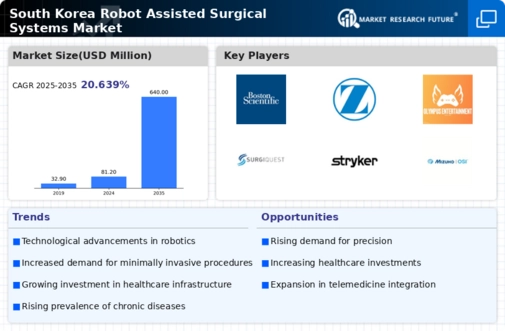Surge in Chronic Diseases
The prevalence of chronic diseases in South Korea is a significant factor driving the robot assisted-surgical-systems market. With conditions such as cardiovascular diseases, diabetes, and cancer on the rise, there is an increasing need for effective surgical interventions. According to recent statistics, chronic diseases account for over 80% of healthcare costs in the country. This situation compels healthcare facilities to adopt advanced surgical technologies that can improve precision and reduce complications. Robot assisted-surgical-systems offer enhanced capabilities for complex procedures, which is crucial in managing chronic conditions. As the population ages and the burden of chronic diseases escalates, the demand for robotic surgical systems is likely to grow, thereby propelling the market forward.
Regulatory Support and Standards
Regulatory support and the establishment of standards for robotic surgical systems are crucial drivers for the market. In South Korea, the government has been proactive in creating a regulatory framework that encourages innovation while ensuring patient safety. This supportive environment fosters the development and adoption of robot assisted-surgical-systems. Regulatory bodies are working to streamline the approval processes for new technologies, which can significantly reduce time-to-market for innovative surgical systems. Additionally, the establishment of clear standards helps build trust among healthcare providers and patients, further promoting the use of robotic systems in surgical procedures. As regulatory support continues to strengthen, the robot assisted-surgical-systems market is poised for substantial growth.
Increasing Healthcare Expenditure
The rising healthcare expenditure in South Korea is a pivotal driver for the robot assisted-surgical-systems market. As the government and private sectors allocate more funds towards healthcare, the demand for advanced surgical technologies is likely to increase. In 2023, healthcare spending in South Korea reached approximately $200 billion, reflecting a growth of around 6% from the previous year. This trend suggests that hospitals and surgical centers are more inclined to invest in robotic systems to enhance surgical outcomes and operational efficiency. Furthermore, the increasing focus on improving patient care and reducing recovery times aligns with the capabilities of robot assisted-surgical-systems, making them an attractive option for healthcare providers. As expenditure continues to rise, the market for these systems is expected to expand significantly.
Growing Awareness of Surgical Options
There is a growing awareness among patients and healthcare professionals regarding the benefits of robot assisted-surgical-systems, which is driving market growth. Patients are increasingly seeking minimally invasive surgical options that promise quicker recovery times and reduced pain. This shift in patient preference is prompting healthcare providers to invest in robotic systems that can meet these demands. Educational campaigns and outreach programs in South Korea are enhancing understanding of robotic surgeries, leading to higher acceptance rates. As more patients become informed about the advantages of robotic-assisted procedures, the demand for these systems is likely to rise, thereby positively impacting the robot assisted-surgical-systems market.
Technological Integration in Healthcare
The integration of advanced technologies in healthcare is transforming the landscape of the robot assisted-surgical-systems market. Innovations such as artificial intelligence, machine learning, and enhanced imaging techniques are being incorporated into robotic systems, improving their functionality and effectiveness. In South Korea, hospitals are increasingly adopting these technologies to streamline surgical processes and enhance patient outcomes. For instance, AI-driven robotic systems can assist surgeons in real-time, providing data analytics that can lead to better decision-making during procedures. This technological evolution not only boosts the efficiency of surgeries but also reduces the risk of errors, making robotic systems more appealing to healthcare providers. As technological integration continues to advance, the market for robot assisted-surgical-systems is expected to flourish.





















Leave a Comment